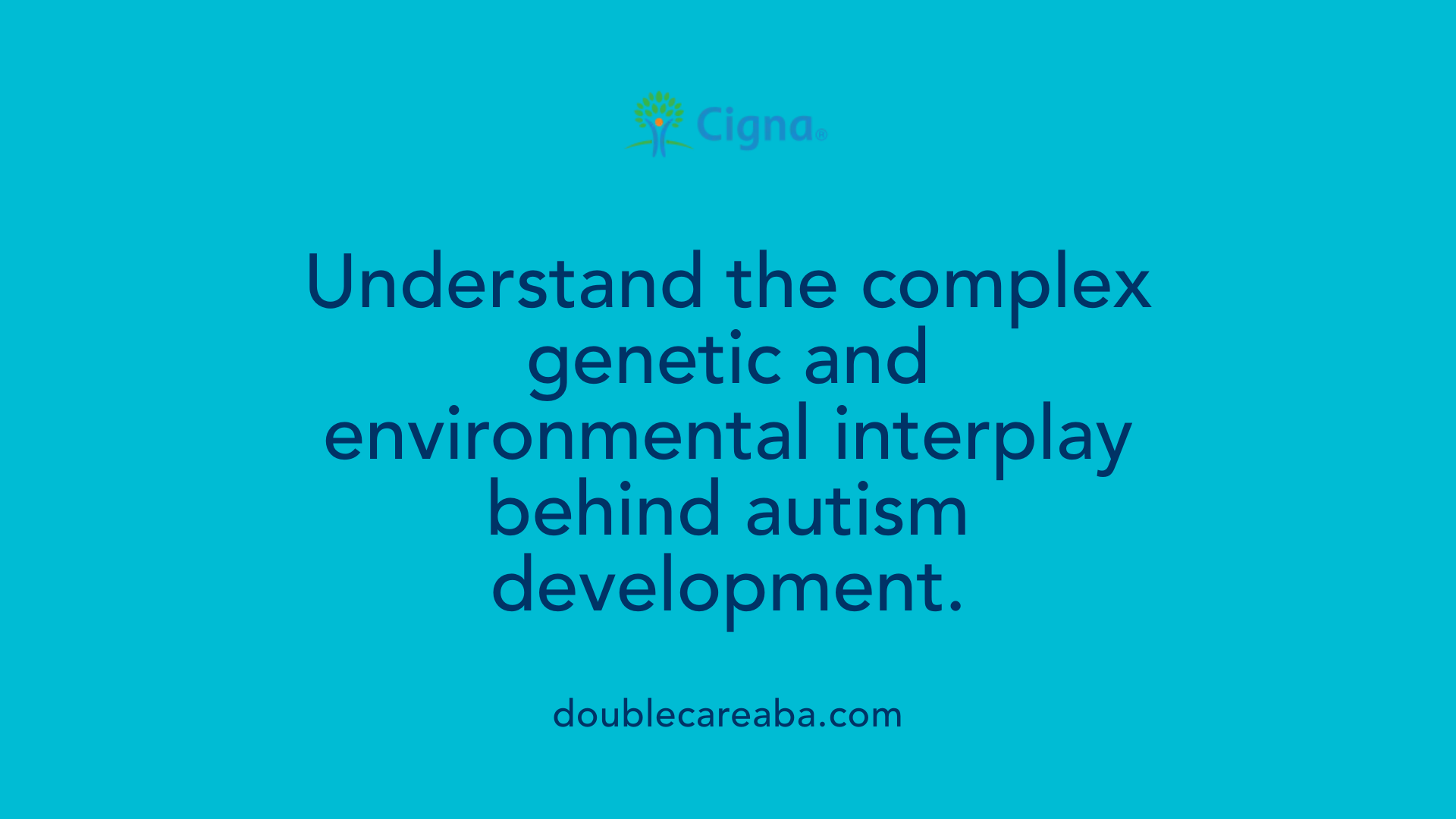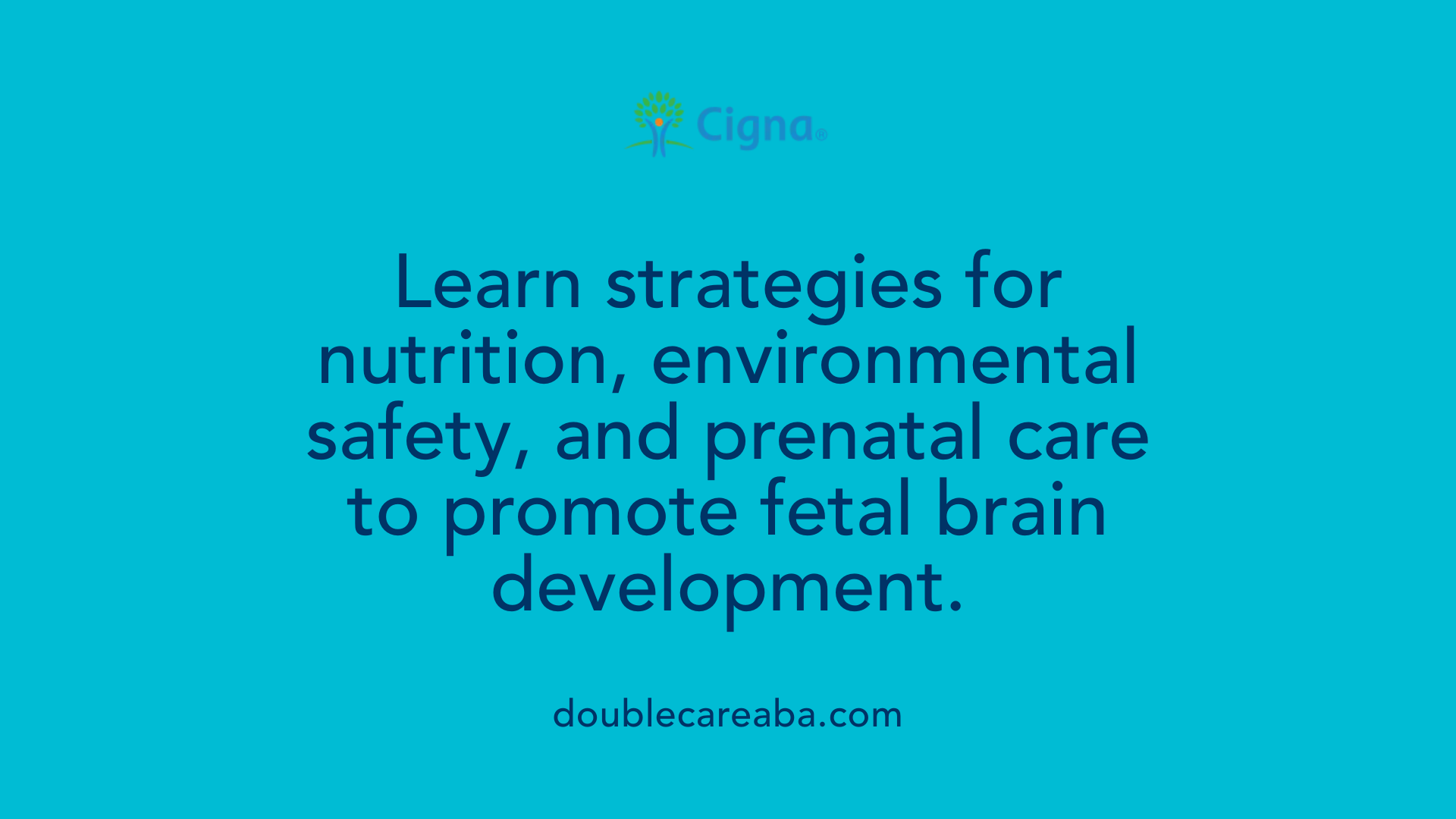Autism During Pregnancy: A Complex Interplay of Genetics and Environment
Autism Spectrum Disorder (ASD) affects approximately 1 in 100 children worldwide, reflecting a high prevalence that is increasing steadily. While the exact causes of ASD remain uncertain, research indicates that a multifactorial interplay of genetic predispositions and environmental exposures during pregnancy significantly influences neurodevelopment. This article explores the various factors during pregnancy that may impact the development of autism, the biological mechanisms involved, and the current state of prenatal detection and prevention strategies.
The Multifactorial Etiology of Autism Spectrum Disorder
 Autism Spectrum Disorder (ASD) affects approximately 1 in 100 children worldwide, making it a relatively common neurodevelopmental condition. Its causes are complex, involving an interplay of genetic and environmental factors that influence early brain development.
Autism Spectrum Disorder (ASD) affects approximately 1 in 100 children worldwide, making it a relatively common neurodevelopmental condition. Its causes are complex, involving an interplay of genetic and environmental factors that influence early brain development.
Genetic factors are significant, with variations contributing to 40% to 80% of autism cases. Specific genetic conditions such as fragile X syndrome and tuberous sclerosis are linked to ASD. Meanwhile, environmental influences during pregnancy also play a crucial role.
Research highlights several prenatal exposures that may increase autism risk. Maternal infections—including rubella, cytomegalovirus, and bacterial infections—and immune activation via inflammatory cytokines like IL-6 can interfere with fetal brain development. Additionally, exposure to pollutants like PM2.5, pesticides, heavy metals, phthalates, and bisphenol A can cross the placental barrier and disrupt neural processes.
Certain medications taken during pregnancy, such as valproic acid, SSRIs, and some anti-seizure drugs, have been associated with increased ASD risk. Maternal health conditions like obesity, gestational diabetes, preeclampsia, and autoimmune diseases further contribute to the likelihood of ASD in offspring. Deficiencies in vital nutrients, especially vitamin D, folate, and iron, are also linked to higher risk, whereas adequate supplementation may offer some protective effects.
The biological mechanisms connecting these factors involve disruptions in neural signaling pathways, including mTOR, Ras, and MAPK pathways. These disruptions may cause structural brain anomalies, imbalances in inhibitory and excitatory signals, and problems with neuron proliferation and connectivity.
Supporting a healthy pregnancy involves measures such as proper nutrition, avoiding harmful substances, and managing maternal health conditions. Adequate prenatal vitamin intake, particularly folic acid and vitamin D, has been shown to decrease ASD risk. Regular medical care and awareness of family history can help optimize fetal development.
In summary, the development of autism stems from a complex web of genetic susceptibilities and environmental exposures that interfere with normal neurodevelopment during pregnancy. Continued research into these factors aims to inform preventive strategies and improve early intervention approaches.
| Factor | Impact on ASD Risk | Additional Notes |
|---|---|---|
| Genetic Variations | 40–80% contribution | Includes fragile X and PTEN mutations |
| Maternal Infection | Increased, especially bacterial; modulates cytokines | Affect fetal brain via immune activation |
| Environmental Pollutants | Associated with increased risk | Air pollution, pesticides, heavy metals |
| Maternal Medications | Certain drugs linked to higher risk | Valproic acid, SSRIs, thalidomide |
| Maternal Health Conditions | Obesity, diabetes, preeclampsia increase risk | Pathways involve inflammation and hormonal changes |
| Nutritional Deficiencies | Vitamin D, folate, iron deficiencies raise risk | Correcting deficiencies may help reduce risk |
| Delivery Method | C-section linked with increased risk | Possibly due to microbiome differences |
| Paternal Age | >40 years increases risk | May involve new mutations in sperm |
Understanding these multifaceted causes enhances our capacity to support healthy pregnancies and develop targeted prevention strategies against autism.
Key Prenatal Factors Influencing Autism Risk

What are some potential factors during pregnancy that may influence the development of autism in the fetus?
Numerous prenatal factors have been linked to the development of autism spectrum disorder (ASD). Maternal health issues such as diabetes, obesity, and hormonal conditions like polycystic ovary syndrome (PCOS) are associated with increased ASD risk, potentially through inflammatory and neurodevelopmental pathways.
Environmental exposures during pregnancy also play a crucial role. Pesticides, heavy metals like mercury and lead, and air pollution—particularly fine particulate matter (PM2.5 and PM10)—have been connected to elevated autism risk in children. These toxicants can cross the placental barrier and disrupt fetal brain development.
Maternal infections, such as rubella, cytomegalovirus, and influenza, along with immune activation triggered by bacterial or viral infections, can increase ASD likelihood. The immune response produces proinflammatory cytokines like IL-6 and IL-17 that may cross the placenta and affect neurodevelopment.
Other factors include advanced paternal age, which has been linked to higher mutation rates in sperm, and the use of assisted reproductive technologies (ART), such as IVF or ICSI, although findings vary. Birth complications, prematurity, and low birth weight also correlate with greater autism risk.
Certain medications during pregnancy have been associated with ASD; for example, valproic acid and some anti-seizure drugs, as well as SSRIs, particularly during the first trimester.
How does maternal health impact the risk of autism in offspring?
Maternal health conditions can significantly affect fetal neurodevelopment, often through inflammation, hormonal imbalance, and exposure to environmental toxins. Gestational diabetes and obesity are linked with higher ASD incidences, likely due to increased inflammatory markers and disrupted metabolic processes.
Furthermore, maternal immune activation (such as from infections or autoimmune diseases) can lead to elevated cytokine levels that cross the placenta and impact fetal brain development. These immune responses, along with placental dysfunction and oxidative stress, may contribute to neurodevelopmental alterations associated with autism.
While some maternal diagnoses are associated with increased risk, many are considered early indicators rather than direct causes. Genetic factors often underpin both maternal health conditions and ASD, complicating the causal pathways. Consequently, shared genetics and familial environments significantly influence observed associations.
Understanding and managing maternal health conditions, reducing exposure to environmental toxicants, and early diagnosis are essential steps in addressing autism risk prenatally.
Pregnancy-Related Conditions and Autism Risk
What pregnancy-related conditions or factors are linked to a higher risk of autism?
Certain health conditions and environmental exposures during pregnancy can influence the likelihood of autism spectrum disorder (ASD) in children. Maternal gestational diabetes and obesity are notable risk factors. These conditions are associated with increased inflammation and hormonal disruptions that can affect fetal brain development. For example, maternal obesity heightens the risk of ASD by about 51%, and extreme obesity increases it further.
Preeclampsia, a pregnancy complication characterized by high blood pressure, and birth complications like injuries to the cerebellum or preterm delivery, also raise autism risk. These issues may interfere with normal neurodevelopment during critical periods.
Environmental toxins play a significant role too. Exposure to pesticides such as organophosphates, heavy metals like mercury and lead, and industrial chemicals like phthalates and bisphenol A have been linked to disrupted neurodevelopment. These toxicants can cross the placental barrier, influencing fetal brain growth.
Hormonal imbalances, especially conditions such as hyperandrogenism (excess androgens), may contribute to autism risk, although research continues to explore these associations. Overall, managing maternal health and minimizing environmental toxin exposure during pregnancy are vital strategies to support fetal neurodevelopment.
Can prenatal testing detect autism or predict its likelihood?
Currently, prenatal testing does not provide a definitive diagnosis or forecast for autism. Autism typically becomes evident around age two through behavioral symptoms. Ultrasound scans can sometimes detect abnormalities in fetal brain structure or other growth issues that might indicate increased risk but are not conclusive.
Genetic testing options like carrier screening, chorionic villus sampling, and amniocentesis can identify certain genetic conditions such as fragile X syndrome, which is linked to autism. However, since no single gene causes ASD, these tests cannot reliably predict if a child will develop autism.
Emerging research focuses on blood-based tests and more advanced genetic analyses that may eventually help in early risk assessment. Despite these advancements, autism detection during pregnancy remains limited and primarily focused on understanding associated genetic and environmental factors rather than diagnosis.
Mechanisms Connecting Pregnancy Factors to Autism
What biological mechanisms link pregnancy factors to the development of autism?
Understanding how various prenatal influences contribute to autism involves examining several interconnected biological pathways. These mechanisms include genetic mutations, immune responses during pregnancy, and disruptions in neural connectivity and neurotransmitter systems.
Genetic mutations play a significant role in neurodevelopmental pathways associated with autism. Variations in genes that regulate synaptic function, neural growth, and signaling pathways such as mTOR, Ras, and MAPK are common among individuals with autism. These genetic factors can base the groundwork for altered brain development, but environmental factors during pregnancy may exacerbate or trigger these vulnerabilities.
The immune system's activation during pregnancy is another critical component. Infections and immune responses—known as maternal immune activation (MIA)—release cytokines like IL-6 and IL-17, which can cross the placenta and affect fetal brain development. This immune response may lead to neuroinflammation, impacting neural proliferation, migration, and connectivity. Elevated maternal inflammation markers have been linked to increased autism risk.
Furthermore, environmental exposures such as air pollution, pesticides, heavy metals, and certain medications can induce oxidative stress and hormonal disruptions. These toxicants can alter neural development and disrupt neurotransmitter systems, especially the balance of inhibitory GABA and excitatory glutamate neurons. Such imbalances can impair the formation of neural circuits and result in the atypical brain structures seen in autism.
Disruption of neural connectivity is another mechanism. During critical periods of brain development, adverse factors may interfere with the formation of synapses and neural networks, leading to impaired communication between brain regions. Changes in brain structural connections underpin many behavioral and cognitive features of autism.
In summary, autism risk is influenced by a complex interplay of genetic predispositions and environmental exposures that disrupt normal neurodevelopment through pathways involving genetic mutations, neuroinflammation, and altered neural connectivity. These mechanisms collectively contribute to the structural and functional brain differences characteristic of autism spectrum disorder.
Signs of Autism Risk During Pregnancy

What are the signs that might suggest autism risk during pregnancy?
Identifying early indicators of autism risk during pregnancy involves examining various biological and environmental markers. Ultrasound imaging can reveal abnormalities such as unusual head size or brain structure anomalies, which have been associated with neurodevelopmental concerns, including autism.
Genetic screening during pregnancy, although not conclusive for autism itself, can detect genetic variations linked to the disorder, such as mutations associated with fragile X syndrome or tuberous sclerosis. Blood tests measuring inflammatory markers, metabolic disturbances, or immune activation—like elevated C-reactive protein levels—may provide additional insights, as maternal inflammation has been connected to increased autism risk.
Environmental exposures during pregnancy also serve as important indicators. These include maternal infections (viral or bacterial), exposure to air pollution, pesticides, heavy metals, and certain medications such as SSRIs or valproic acid. These factors can influence fetal neurodevelopment either directly or through inflammatory pathways.
While these signs can suggest a higher likelihood of autism, none serve as definitive predictors. Ongoing research continues to improve our understanding, aiming to refine early detection strategies to enable timely interventions.
| Indicator Type | Typical Markers/Signs | Additional Details |
|---|---|---|
| Ultrasound markers | Abnormal head size, brain structure anomalies | May reflect early brain development issues |
| Genetic and blood markers | Genetic variations, elevated inflammatory cytokines | Offer probabilistic risk assessments but are not conclusive |
| Environmental, health-related factors | Maternal infections, pollution exposure, medication use | Can influence fetal development via inflammation or toxicity |
Understanding these indicators can help healthcare providers monitor at-risk pregnancies and potentially initiate early interventions.
Autism in Young Children: Early Developmental Signs and Early Interventions
When do initial signs of autism typically appear?
Autism spectrum disorder (ASD) usually becomes noticeable around age two, though some signs can be observed earlier. Early identification is essential to support development and learning.
What are behavioral and developmental indicators?
In young children, signs of autism can include delays in language development, difficulties with social interactions, repetitive behaviors, and limited eye contact. Children may also display unusual sensory sensitivities, such as overreacting or underreacting to sounds, sights, or textures.
Why is early diagnosis and intervention important?
Detecting autism signs early enables families to access therapies and educational programs that can significantly improve developmental outcomes. Interventions like speech therapy, behavioral therapy, and social skills training are most effective when started during early childhood.
How does maternal health impact the risk of autism in offspring?
Maternal health conditions during pregnancy can influence neurodevelopment. Factors such as maternal infections, obesity, diabetes, and exposure to environmental toxins like air pollution and heavy metals are linked to increased ASD risk. These influences often involve inflammatory pathways, hormonal imbalances, and toxin exposure, affecting fetal brain development.
Although many associations exist, much of the evidence points to complex interactions between genetic and environmental factors. Maternal infections, particularly bacterial, and immune responses during pregnancy have also been studied for their roles in neurodevelopment. Nonetheless, recent large-scale studies suggest that most maternal health conditions may be markers or early signs rather than direct causes of autism.
In summary, recognizing early developmental signs of autism and understanding maternal health factors are vital steps toward timely intervention. Continued research helps clarify these connections, emphasizing the importance of maternal well-being and early childhood support systems.
For more detailed information on early signs and intervention strategies, search queries like "early childhood signs of autism and intervention" can provide useful resources.
Implications for Supporting a Healthy Pregnancy

Are there strategies to support a healthy pregnancy and reduce the risk of autism?
Supporting a healthy pregnancy is crucial for fetal brain development and may help lower the risk of neurodevelopmental disorders such as autism spectrum disorder (ASD). Although no certain way exists to prevent autism due to its complex etiology, certain practices can contribute to a healthier gestational period.
One effective strategy is ensuring adequate nutritional intake. Folic acid supplementation before conception and during early pregnancy has been linked with a significant reduction in autism risk, with women taking folic acid around the time of conception being about 40% less likely to have a child with autism. Vitamin D is another nutrient of interest; deficiency during pregnancy more than doubles the risk of ASD, but supplementation with higher doses (such as 5000 IU/D) may offer protective benefits. Iron and omega-3 fatty acids, particularly during pregnancy, are also associated with better neurodevelopmental outcomes.
Avoiding exposure to harmful substances is equally important. This includes steering clear of tobacco, alcohol, and environmental pollutants like air pollution, pesticides, heavy metals, phthalates, and bisphenol A. These toxicants can cross the placenta and interfere with fetal brain development, increasing the risk of ASD. Additionally, steering clear of unsafe medications, such as high fetal exposure to acetaminophen, may help reduce risk.
Regular prenatal care plays a vital role in monitoring pregnancy health. Routine screenings, managing health conditions like gestational diabetes and hypertension, and screening for infections are essential steps. Prompt treatment of maternal infections and immune responses can mitigate their impact on fetal neurodevelopment.
While these measures emphasize fostering a healthy pregnancy, it is important to recognize that ASD has multifactorial causes, including genetic influences. These strategies might lower some environmental risks but do not entirely prevent autism.
In summary, a combination of good nutrition, avoiding environmental and substance hazards, and consistent prenatal healthcare create a foundation that supports fetal development and may contribute to reducing certain risk factors associated with autism risk.
| Strategy | Specific Actions | Impact on ASD Risk |
|---|---|---|
| Nutritional Supplements | Folic acid, vitamin D, iron, omega-3 fatty acids | Reduce maternal deficiency-related risks; support brain development |
| Avoidance of Harmful Substances | Tobacco, alcohol, pollutants, certain medications | Reduce toxin exposure; potential neurodevelopmental benefit |
| Regular Prenatal Care | Screening, infection management, health condition control | Monitor and address risks early; promote overall pregnancy health |
Understanding and implementing these practices can optimize pregnancy outcomes and contribute to healthier neurodevelopment in children.
Biological Effects of Environmental Exposures During Pregnancy

What environmental exposures during pregnancy may influence autism risk?
During pregnancy, certain environmental factors can impact fetal neurodevelopment and potentially increase the risk of autism spectrum disorder (ASD). These exposures include air pollution, pesticides, heavy metals, microplastics, and chemical additives. Each of these toxicants can interfere with normal brain development through various biological pathways.
One major concern is air pollution, especially fine particles like PM2.5 and PM10. These pollutants can cross the placental barrier and induce inflammation and oxidative stress within the fetal environment. Chronic exposure has been linked to disruption of normal neural growth, contributing to neurodevelopmental disorders such as autism.
Pesticides, such as organophosphates and organochlorines, are another group of toxicants associated with neurodevelopmental issues. These chemicals can alter hormonal regulation and interfere with neurotransmitter systems. When pregnant women are exposed to such pesticides, there’s an increased likelihood of disruptions in fetal neural pathways.
Heavy metals—including mercury, lead, arsenic, and cadmium—pose significant risks when ingested or inhaled during pregnancy. These metals can impair mitochondrial function, cause oxidative damage, and disturb hormonal balances critical for brain development. Their accumulation in the fetal brain may lead to neurodevelopmental impairments related to ASD.
Further, microplastics and associated chemical additives like phthalates and bisphenol A (BPA) can cross the placenta and impact fetal brain development. These substances may mimic hormones or alter gene expression, leading to developmental disruptions that increase autism risk.
Understanding these biological effects underscores the importance of minimizing environmental toxicant exposures during pregnancy. Reducing contact with pollutants and chemicals can play a role in safeguarding fetal neurodevelopment and lowering ASD incidence.
| Exposure Type | Common Toxicants | Biological Impact | Potential Outcomes |
|---|---|---|---|
| Air Pollution | PM2.5, PM10 | Induces inflammation and oxidative stress | Disrupted neural development, increased ASD risk |
| Pesticides | Organophosphates, organochlorines | Hormonal disruption, neurotransmitter interference | Neurodevelopmental delays, ASD |
| Heavy Metals | Mercury, lead, arsenic, cadmium | Mitochondrial damage, oxidative stress | Cognitive impairments, ASD susceptibility |
| Microplastics & Additives | Phthalates, BPA | Hormone mimicry, gene expression alteration | Fetal brain disruption, potential ASD link |
Role of Genetics and Family History in Autism Risk
Can prenatal testing detect autism or predict its likelihood?
Prenatal tests are not capable of definitively diagnosing autism spectrum disorder (ASD). While they can identify certain genetic conditions linked to autism, such as fragile X syndrome, they do not provide a clear prediction of whether a child will develop autism. Autism is primarily diagnosed based on observed behaviors typically around age two, as it results from complex interactions between genetics and environmental factors that current testing methods cannot fully unravel.
Genetic variations are estimated to contribute between 40% and 80% of autism cases. Tests like carrier screening, chorionic villus sampling (CVS), amniocentesis, and noninvasive prenatal testing (NIPT) can detect genetic mutations or syndromes associated with ASD, but they cannot confirm the presence of autism itself.
How does maternal health impact the risk of autism in offspring?
Many maternal health factors have been studied regarding their influence on autism risk. Conditions such as maternal infections, obesity, and vitamin deficiencies have shown associations with increased risk. However, these associations are often confounded by familial and genetic influences.
Research indicates that shared genetics and familial traits play a significant role, meaning that what appears as a causal effect of maternal health might actually reflect inherited susceptibilities. For example, several studies controlling for family history suggest that maternal complications are more likely early signs or correlates rather than direct causes of ASD.
An example is the finding that paternal diagnoses show similar associations with autism, further supporting the influence of inherited genetic factors. Consequently, while maternal health conditions can signal higher autism risk, they are intertwined with genetic and familial predispositions.
| Aspect | Influence | Notes |
|---|---|---|
| Genetic Variations | Major contributor, 40-80% of cases | Detectable via specific genetic tests, but not predictive of autism outcome |
| Maternal Health Factors | Associated with increased risk | Often confounded by familial and genetic factors |
| Family and Paternal Diagnoses | Similar associations | Highlight the role of inherited genetics |
Understanding the interplay between genetics, family history, and maternal health continues to guide research toward better risk assessment and early intervention strategies.
Addressing Misconceptions and Providing Scientific Evidence
Are there misconceptions about pregnancy and autism causality?
Many believe that specific maternal health issues or environmental exposures during pregnancy directly cause autism in children. However, recent large-scale studies suggest a more complex picture. For instance, maternal conditions like preeclampsia, certain infections, or exposure to pollutants are associated with increased autism risk, but these associations do not confirm direct causation.
Instead, much of the evidence points to confounding factors such as familial genetics and shared environmental influences. For example, a comprehensive study analyzing over 1.1 million pregnancies from Denmark showed that only pregnancy complications directly related to the fetus were associated with autism; most other associations were linked to genetic and familial factors.
What is the role of large population studies?
Population studies are crucial for understanding autism's complex etiology. These studies examine thousands or even millions of pregnancies, offering robust data to parse out real risk factors from coincidental associations. They help differentiate between true causal relationships and familial or genetic confounders.
For example, research from NYU Langone Health and Danish health records has shown that common maternal diagnoses during pregnancy are not necessarily causes of autism, but rather markers or early signs of neurodevelopmental patterns.
Can prenatal testing detect autism or predict its likelihood?
Currently, there are no definitive prenatal tests to diagnose autism. While genetic testing—including carrier screening, CVS, amniocentesis, and noninvasive methods—can identify certain genetic conditions linked to autism, these do not predict whether a child will develop ASD. Autism diagnosis relies on behavioral assessments typically conducted around age two.
Ongoing research aims to identify early biomarkers through genetic, neuroimaging, and biochemical studies. For now, understanding the multifactorial influences—genetic, environmental, and maternal health—remains vital for early intervention strategies.
| Topic | Key Facts | Details |
|---|---|---|
| Prenatal predictors | No definitive tests | Current tests cannot reliably predict autism; diagnosis is behavioral. |
| Genetic factors | 40-80% contribution | Variations and conditions like fragile X or tuberous sclerosis are linked. |
| Environmental factors | Associations exist | Pollution, maternal illnesses, and exposures influence risk but are not direct causes. |
| Large-scale research | Validates findings | Studies differentiate causal from correlational factors, emphasizing genetics and family history. |
Understanding the nuanced relationship between prenatal factors and autism helps clarify misconceptions and guides future research efforts.
The Importance of Continued Research and Future Directions
What biological mechanisms link pregnancy factors to the development of autism?
Understanding how pregnancy influences autism development involves exploring complex biological pathways. Disruptions in neurodevelopmental processes can result from a combination of genetic mutations and environmental factors faced during gestation.
One significant pathway involves immune activation, where maternal infections or inflammation trigger the release of cytokines, such as IL-6 and IL-17. These cytokines can cross the placental barrier and interfere with fetal brain development, increasing autism risk.
Another mechanism includes mitochondrial dysfunction, which is influenced by immune responses and oxidative stress caused by infections or toxicant exposures like heavy metals. This dysfunction can impair neuronal growth and connectivity.
Additionally, alterations in the maternal microbiome during pregnancy—affected by antibiotics, diet, and environmental exposures—may impact fetal neurodevelopment. Changes in gut bacteria can influence immune responses and hormone production, both relevant to autism.
Emerging research is also investigating the role of endocrine disruptors, such as phthalates and bisphenol A, which cross the placenta and disturb hormonal balances essential for brain maturation.
Ongoing studies utilize advanced genetic analyses, including identifying mutations and variations associated with autism, and biomarker discovery to understand these pathways better. The ultimate goal is to pinpoint intervention points to prevent or reduce autism risk stemming from prenatal factors.
How do these findings shape future research directions?
Current research emphasizes a multidisciplinary approach, integrating genetics, immunology, toxicology, and microbiome studies. Researchers are particularly interested in developing blood tests and genetic analyses that could predict susceptibility or early signs of autism.
Understanding immune responses and the microbiome's influence during pregnancy might lead to targeted therapies or lifestyle modifications. For instance, managing maternal inflammation or optimizing microbiome health might mitigate some risks.
Overall, expanding knowledge on these biological mechanisms can inform preventative strategies and tailored interventions, reducing the societal and individual burden of autism. As research progresses, more precise, early detection methods and potential avenues for prenatal intervention are anticipated.
Awareness of environmental and genetic interplay
While maternal health and environmental exposures are crucial, genetic factors also play a considerable role, contributing about 40-80% of cases. Combining genetic screening with environmental risk assessments can enhance our understanding of autism etiology.
This integrated perspective fosters comprehensive research models that consider the full spectrum of influences during pregnancy. Future studies aim to unravel how these factors interact dynamically to influence neurodevelopment and how best to address these risks.
| Area of Research | Focus | Potential Impact |
|---|---|---|
| Blood Tests and Genetics | Identifying early biomarkers and gene variations | Improved early diagnosis and personalized prevention |
| Immune and Microbiome Studies | Exploring immune activation pathways and gut-brain interactions | New therapeutic targets and risk mitigation strategies |
| Toxicology and Hormonal Studies | Examining environmental toxins and hormonal disruptions | Policy changes and public health recommendations |
This comprehensive research approach underscores the importance of understanding the multifaceted nature of autism risk factors during pregnancy, paving the way for more effective prevention and intervention measures.
Supporting Healthy Pregnancies for Better Neurodevelopmental Outcomes
While current science underscores the complexity of autism's origins and the interplay of genetic and environmental factors, it also highlights actionable areas for supporting healthier pregnancies. Adequate nutritional intake, minimizing exposure to toxins, managing maternal health conditions, and early detection for high-risk pregnancies are critical steps. Continued research into biological mechanisms and early biomarkers promises to enhance preventive strategies and early interventions, strengthening our capacity to improve neurodevelopmental outcomes for future generations.
References
- The Autism Spectrum Disorder and Its Possible Origins in Pregnancy
- No Evidence That Maternal Sickness During Pregnancy Causes ...
- Pregnancy and childbirth - National Autistic Society
- Can you test for autism during pregnancy? What you need to know
- Prenatal environmental risk factors for autism spectrum disorder and ...
- Autism Spectrum Disorders: Exploring Pregnancy and Birth Factors
- How pregnancy may shape a child's autism | The Transmitter
- Asthma, obesity during pregnancy linked to autism in children
- Maternal Infection during Pregnancy and Autism Spectrum Disorders
- Supporting a Healthy Pregnancy - The Autism Community in Action














